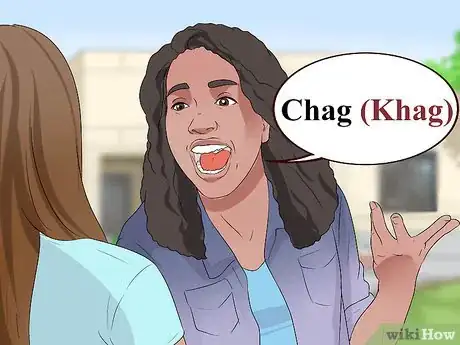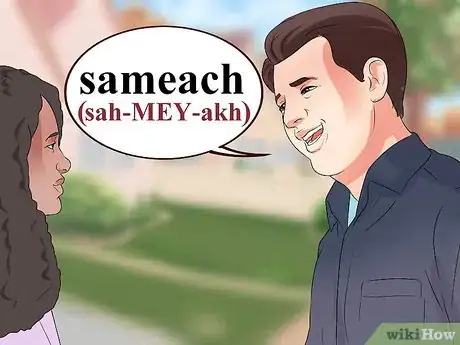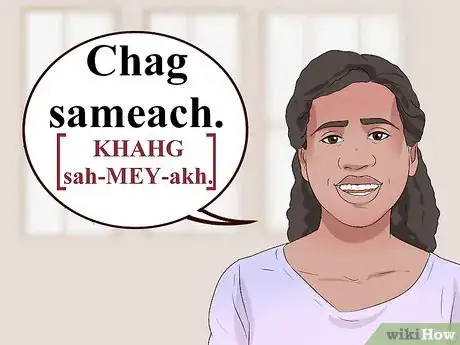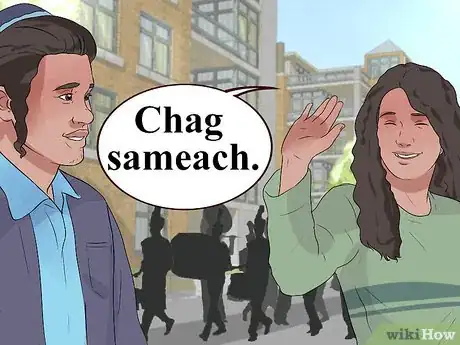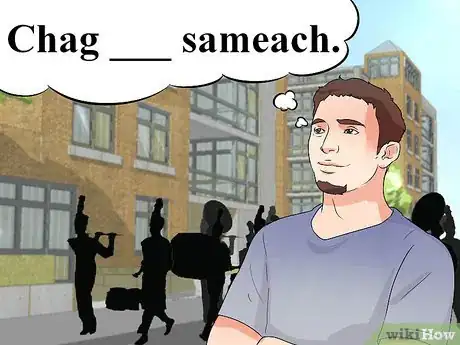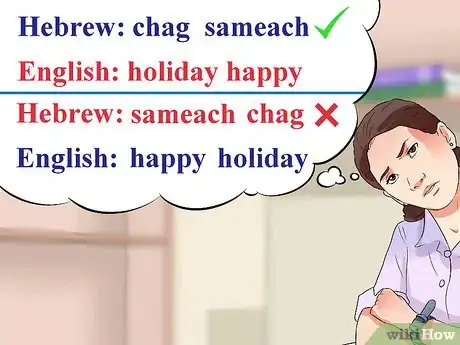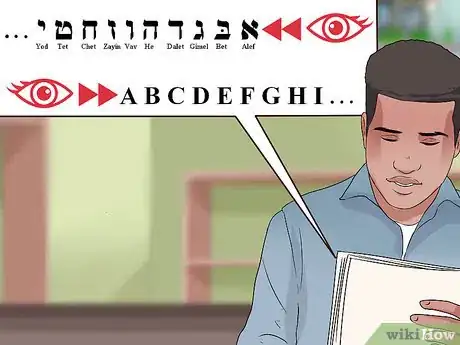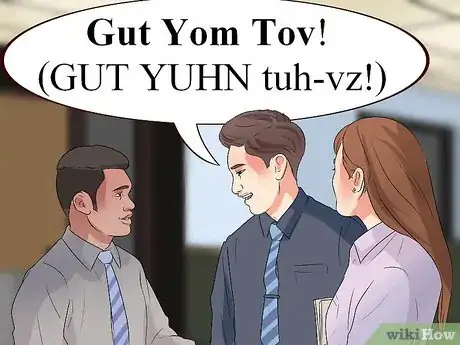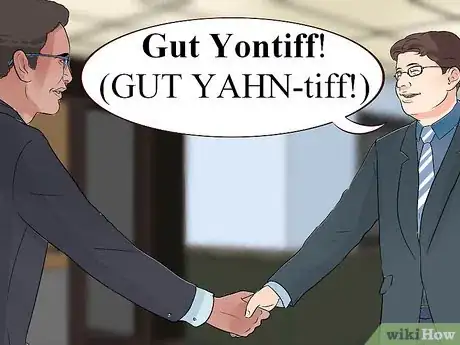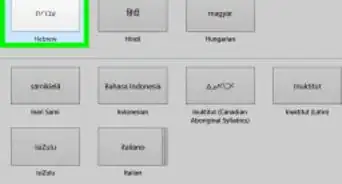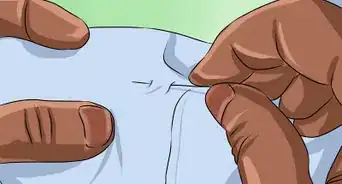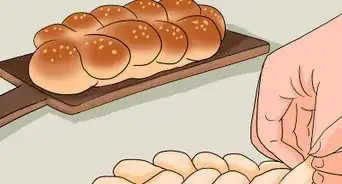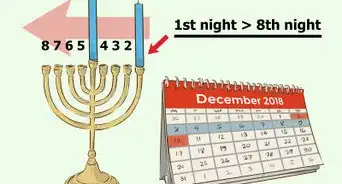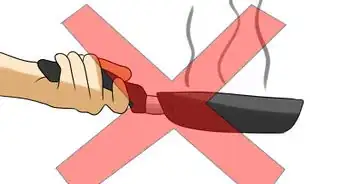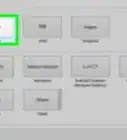This article was co-authored by wikiHow Staff. Our trained team of editors and researchers validate articles for accuracy and comprehensiveness. wikiHow's Content Management Team carefully monitors the work from our editorial staff to ensure that each article is backed by trusted research and meets our high quality standards.
There are 8 references cited in this article, which can be found at the bottom of the page.
This article has been viewed 101,761 times.
Learn more...
There are many Jewish holidays and festivals, each with a unique Hebrew greeting. Learning each one would be difficult for someone with a rudimentary understanding of Hebrew. There are, however, phrases and sayings that can be used to convey something similar to the English phrase “happy holidays.” Learning these greetings will help you express your holiday spirit with your Jewish friends and neighbors.
Steps
Saying “Chag Sameach”
-
1
-
2Use the word “sameach” for “happy.” In Hebrew, “simcha” is the word for happiness and “sameach” is the adjective form. The word is pronounced “sah-MEY-akh,” using a hard “k” sound from the back of the throat. Say it after you say “chag.”[3]
- Do not pronounce it with the English “ch” sound. [4]
Advertisement -
3Combine “chag” and “sameach.” Try saying the words together as a phrase, “chag sameach.” Concentrate on the correct pronunciation of the individual words in the phrase. Practice saying the entire phrase and pronouncing it “KHAHG sah-MEY-akh.” [5]
- Sephardic Jews prefer using the greeting “chag sameach.”
Understanding Chag Sameach
-
1Use “Chag sameach” for many Jewish holidays. This greeting can be used for most Hebrew festivals and holidays. It is particularly appropriate for Sukkot, Shavu’ot and Passover since they are technically the only festivals. [6]
- If you are unsure on what to say, what for the other person to speak and repeat what they say.
-
2Understand that certain holidays have specific sayings. Although “chag sameach” may work as a catchall holiday greeting, there are Hebrew sayings that are more specific and appropriate depending on the holiday. Be sure to learn these alternative sayings as well. [7]
- You can often place the holiday name in between “chag” and “sameach” to create a more specific greeting.
-
3Know that Hebrew syntax is different than that of English. In Hebrew, word order is not as important as it is in English and whether an adjective comes before or after a noun is less relevant. Because of this, adjectives can come before or after a noun and still have the same meaning.[8]
- Although “holiday happy” may sound strange to English ears, “Chag Sameach” makes perfect sense to Hebrew speakers.
- Try not to say “Sameach Chag” since that is not the saying and you might get laughed at.
-
4Learn the Hebrew alphabet. Hebrew uses a different alphabet than English and is read from right to left. Hebrew characters look different and have different accompanying sounds than their English counterparts. Knowing this alphabet, and the accompanying pronunciations, will help you better understand Hebrew and communicate it to others. [9]
- Hebrew is a combination of an early Semitic alphabet with some Greek characters.
- There are no vowels in Hebrew. However, there is a system of dots and dashes known as nikkuds that indicate vowels.
-
5Listen to Hebrew. One of the best ways to learn a language is to hear it spoken by native speakers. Find recordings online of people speaking in Hebrew. You can also immerse yourself by watching Israeli television and movies.
- Begin by learning the pronunciations of the individual letters in the Hebrew alphabet.
-
6Immerse yourself in Hebrew. If you have the time and resources, try living in Israel for an extended period of time. The experience will force you to develop an ear for Hebrew and pick up much of the language. Although it may be difficult at first, immersion is the best way to learn another language quickly.[10]
- Many people in Israel speak English, so be sure to use Hebrew at every opportunity.
Speaking Other Phrases
-
1Make “Chag Sameach” more holiday specific. Insert the names of Jewish holidays between “chag” and “sameach” to speak a create a specific Hebrew greeting. You can use this style of greeting for nearly any holiday. However, it most appropriate with Sukkot, the Feast of Weeks, and Passover, which are technically the only festivals.[11]
- For Passover say, “Chag Pesach Sameach.” It is pronounced “KHAHG PAY-sahk sah-MEY-akh.”
- For Sukkkot say, “Chag Sukkot Sameach.” It is pronounced “KHAHG suu-KOHT sah-MEY-akh.”
- For the Feast of Weeks say, “Chag Shavu’ot Sameach” It is pronounced “KHAHG shah-voo-AWT.”
-
2Impress others with “chag kasher v’sameach.” Pronounced “KHAHG kah-SHEHR vuh-sah-MEY-akh,” this is a fancier way of saying happy holidays. It means “have a happy and kosher holiday.” It is a reference to Jewish dietary law known as Kashut or Kosher. Although it can be used for any holiday, it is typically said at Passover.[12]
-
3Say “Gut Yom Tov” for a traditional Ashkanazi greeting. This saying combines the Yiddish word “gut,” or “good,” with the Hebrew words “yom tov,” or “good day.” It is pronounced “YUHN tuh-vz” This phrase, which literally means “good good day,” can be used for any holiday.[13]
- Gut rhymes with put.
- Although not strictly Hebrew, this phrase is not uncommon in the Jewish world.
-
4Try “Gut Yontiff” for a well-known Yiddish greeting. This Yiddish saying is a derivation of “gut Yom Tov.”[14] Pronounced “Gut YAHN-tiff,” this phrase was used by Europe’s Jews for centuries and it was not until the early twentieth century that it fell out of style. “Gut Yontiff” was particularly popular Jewish communities of the Pale in Eastern Europe.
- Many Jewish people in the United States and Israel still use or recognize “gut yontiff” as a holiday greeting.
Community Q&A
-
QuestionWhat is Hebrew for our Christmas time?
 Community AnswerIf you wanted to wish someone a "Merry Christmas" you would say "Chag Molad Sameach!" "Molad" is the Hebrew word for Christmas.
Community AnswerIf you wanted to wish someone a "Merry Christmas" you would say "Chag Molad Sameach!" "Molad" is the Hebrew word for Christmas. -
QuestionHow do you spell "Merry Christmas" in Hebrew letters?
 Community AnswerFrom left to right, it is חג מולד שמח.
Community AnswerFrom left to right, it is חג מולד שמח. -
QuestionHow do I say, "many thanks" in Hebrew?
 Community Answerהרבה תודות pronounced harbah todah. That is literally translated, but for a less direct translation, you can say todah rabah.
Community Answerהרבה תודות pronounced harbah todah. That is literally translated, but for a less direct translation, you can say todah rabah.
References
- ↑ https://www.chabad.org/library/article_cdo/aid/2315973/jewish/Holiday-Greetings.htm
- ↑ http://forvo.com/word/chag_sameach/
- ↑ https://www.chabad.org/library/article_cdo/aid/2315973/jewish/Holiday-Greetings.htm
- ↑ http://forvo.com/word/chag_sameach/
- ↑ http://forvo.com/word/chag_sameach/
- ↑ https://www.chabad.org/library/article_cdo/aid/2315973/jewish/How-Jews-do-Holiday-Greetings.htm
- ↑ https://www.chabad.org/library/article_cdo/aid/2315973/jewish/How-Jews-do-Holiday-Greetings.htm
- ↑ http://www.dummies.com/how-to/content/making-sense-of-hebrew-syntax.html
- ↑ http://www.jewishvirtuallibrary.org/jsource/Judaism/alephbet.html
- ↑ http://rer.sagepub.com/content/55/4/541.short
- ↑ https://en.wikipedia.org/wiki/Jewish_greetings
- ↑ https://en.wikipedia.org/wiki/Jewish_greetings
- ↑ https://www.chabad.org/library/article_cdo/aid/2315973/jewish/Holiday-Greetings.htm
- ↑ http://forward.com/culture/114175/fronting-and-assimilating-to-a-gut-yontif/
